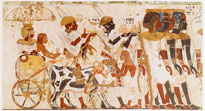Egyptians see Nubians as subjects
These paintings from the tomb of Huy, the Egyptian governor of Nubia during the reign of King Tutankhamun (1336–1327 BC), pictures Nubians bringing tribute for Egypt’s pharaoh. The scene shows a wide variety of Nubians. Some are in Egyptian dress, including a woman riding in a cart. Others, including children, appear in Nubian dress. The skin color of the Nubian men ranges from dark red to brown to black; skin tones for some of the women are lighter.
Details show that Nubia is foreign

A kneeling prince (at right in imge below) leading the tribute bearers is identified as Hekanefer, Prince of Miam (Aniba), a region of northern Nubia. Hekanefer’s dress is Nubian. Details like the ostrich feather and panther skin he wears, along with other exotic products, serve to indicate that Nubia is the geographic source of these items. Exotic goods and Hekanefer’s traditional dress emphasize the foreign nature of the Nubians in the Egyptian world.
The Nubian prince Hekanefer had an Egyptian-style tomb

Despite being shown as a traditional Nubian in the tomb painting of Huy (below), Hekanefer’s own tomb reveals that he was acculturated to Egyptian religious beliefs and customs. Discovered at Toshka in northern Nubia during the 1960s, Hekanefer’s tomb contained the funerary figurine (ushebti), pictured here at left. The ushebti was a traditional Egyptian servant figure placed in the tomb to perform labor for the deceased in the afterworld.

